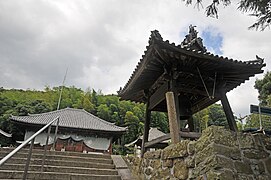Jōdo-ji (Matsuyama)
The Jōdo-ji ( Japanese 浄土 寺 ) with the Go Sairinzan ( 西林 山 ) and Sanzōin ( 三 蔵 院 ) is a temple of the Buzan direction ( 豊 山 派 ) of Shingon Buddhism in the city of Matsuyama ( Ehime Prefecture ). In the traditional count, it is the 49th temple on the Shikoku pilgrimage route .
history
According to tradition, the temple was built by Priest Keimei ( 恵 明 上人 ) at the request of Empress Kōken . Priest Gyōki made a statue of Shaka Nyorai for the temple. At that time the temple is said to have belonged to the Hosso direction of Buddhism. Later, Priest Kūkai visited the temple, rebuilt the dilapidated complex and now dedicated the temple to the Shingon direction. The temple flourished and eventually had 66 sub-temples.
When priest Kūya Shikoku wandered through in the middle Heian period , he tried harder in the Tendoku years (957–961) to win the rural population through teaching for the faith. The temple later became less important, but Prince Minamoto no Yoritomo restored the temple to its splendor. In 1416 the temple burned down during the civil war, but could be renewed in the Bummei years (1469-1487) by the ruler of the area, Prince Kōno Michinobu ( 河野 道 宣 ; † 1519).
The attachment
You enter the temple complex from the street through the temple gate, which is designed here as a two-story Niō gate ( 仁王 門 ; 1 on the plan), i.e. as a gate with the place for the temple guards to the right and left of the passage. The guardian figures are present at this temple. You climb a few steps to the next level and pass the bell tower on the right ( 鐘楼 , Shōrō ; 2).
After further steps you stand in front of the main hall ( 本 堂 , Hondō; 3). It is designed in the "mixed style" , has a square floor plan with a distance between the pillars of about 9.1 m and has a tiled roof in the "four-pillar style" ( 四柱 作 , Shichō-zukuri ). The main hall is registered as an Important Cultural Property of Japan . To the right of the main hall is the hall dedicated to the temple founder, the Daishidō ( 大師 堂 ; 4), to the left the Amidadō ( 阿 弥陀 堂 ; 5). Further to the left is the Aizendō ( 愛 染 堂 ; 6).
At the entrance to the temple is a stone with a poem by the Matsuyama-born poet Masaoka Shiki , for example "In November, Kūya lived on bones"
Treasures
The wooden sculpture of Kūya, registered as an important cultural asset, is located in a shrine in the main hall. It is 121.5 cm high and has rock crystal eyes. Six small Buddha figures emerge from Kūya's mouth one after the other. A Kūya pine tree is growing in the second generation in the abbey garden. Doodles can be seen on Kūya's shrine, ranging from the Muromachi period to the Edo period . They are important traces of history.
In the Sanzōin ( 三 蔵 院 ) were the statues of the founder of the Jodō doctrine, Hōnen , and his successors Shōkō ( 聖光 ; 1162-1238) and Ryōchō ( 良忠 ; 1199-1287). The statues were moved to another temple during the Pacific War and were lost to air raids when it was destroyed in 1945.
photos
Remarks
- ↑ 霜 月 の 空 也 は 骨 に 生 き に け る , Shimotsuki no Kūya wa hone ni iki ni keru.
literature
- Ehime-ken kotogakko chireki komin bukai rekishi bukai (Ed.): Jōdo-ji . In: Ehime-ken no rekishi sampo. Yamakawa Shuppan, 2008. ISBN 978-4-634-24638-6 . Pages 47, 48.
- Oguri, Doei: Kukai. Shikoku hachijuhachi kosho no arukikata. Chukei no Bunko, 2011, ISBN 978-4-8061-4067-2 .
Web links
Coordinates: 33 ° 49 ′ 0 ″ N , 132 ° 48 ′ 30.7 ″ E







